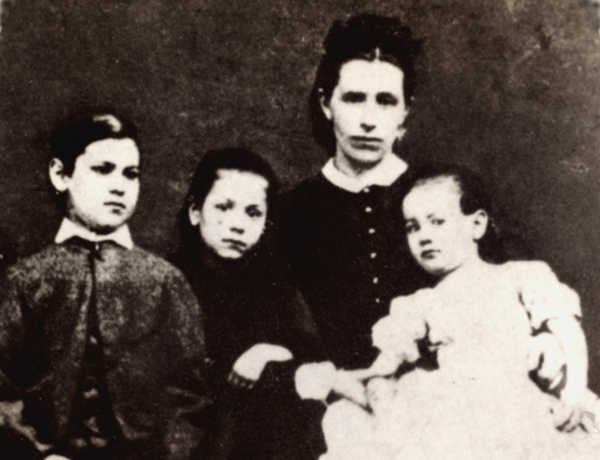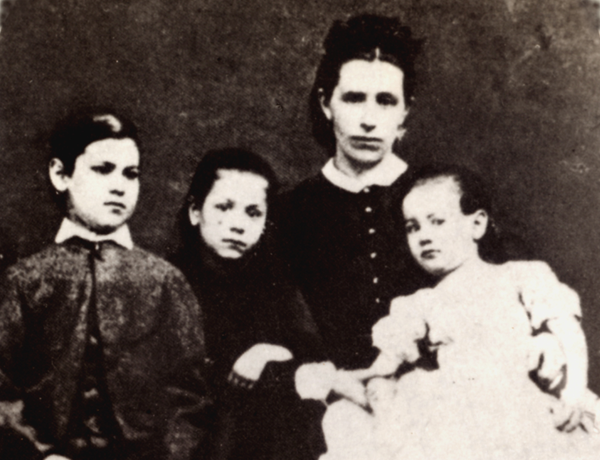
Psychobiography
Sigmund Freud, Son of Amalia
by Marc-André Cotton*—Int. Psychohistorical Association
This article was published in Clio’s Psyche, volume 24, No 2, pp. 137-143 (Winter 2018).
Abstract: Discernible in the works of Freud, imprints of early traumas have been overlooked by biographers. This painful blind spot of the Freudian model accounts for a detrimental lack of concern with mother and infant intimacy.

Explorer of the unconscious, Sigmund Freud has seldom revisited his first three years—his “prehistoric period of life,” as he called it (The Complete Letters of Sigmund Freud to Wilhelm Fliess, March 10, 1898, Belknap Press, 1985, 302). He did mention an ambivalent attitude towards his father Jakob, notably in his correspondence with Fliess, but remained silent on his relationship with his mother Amalia. Notorious biographer Ernest Jones even conjectured that “in Freud’s earliest years there had been extremely strong motives for concealing some important phase of his development—perhaps even from himself” (Ernest Jones, The Life and Work of Sigmund Freud, Vol. 2, 1955, 409).
Beyond this apparent need for secrecy, one must seek Freud’s first maternal imprints in his writings and some key passages of his biography. Such early experience—undeniably traumatizing in light of current knowledge on attachment and bonding—might be accountable for the Freudian belief that the child wants to “possess the mother,” as if Freud himself had dreamed to live out this fantasy throughout his life.
Compensating for His Mother’s Despair
Born in 1835, Amalia Nathanson Freud was barely twenty-one years old when her first child was born. He was named Schlomo (Sigismund) in memory of his paternal grandfather, who had died a few weeks earlier. An attractive young lady, Amalia had married a man twice her age, whom she hardly knew, and left Vienna—a European metropolis comparable to Paris—for Freiberg, a Moravian provincial town where her husband held an unrewarding wool business. The reasons for marriage are unclear, but love at first sight seems unlikely. Emphasizing existing sexism at the time, several female investigators suggest that she was “sold” to Jakob Freud, a widower and father of two adult sons, as punishment for a romantic love affair her family disapproved of (Marianne Krüll, Sigmund, fils de Jacob, Gallimard, 1983, 146). Gabrielle Rubin speculates that Amalia was pregnant with her lover’s child when she married Jakob on July 29, 1855 (Gabrielle Rubin, Le roman familial de Freud, Payot, 2002, 58).
One must imagine the young lady’s frustration as, in order to compensate for a profound sense of despair, she would show boundless admiration to her eldest son. The child was born “in a caul”—that is, with part of the amniotic membrane on his head—and popular belief took this as a sign of good fortune. Amalia cherished recollections that reinforced her inner conviction and daughter Anna later wrote: “Perhaps my mother’s trust in Sigmund’s future destiny played a definite part in the trend given his whole life” (Anna Freud Bernays, “My Brother Sigmund Freud,” American Mercury, November 1940, 335, http://www.unz.org/Pub/AmMercury-1940nov-00335). Freud would experience this inner urge for recognition time and time again—as in The Interpretation of Dreams where he asks: “Could this have been the source of my thirst for grandeur?” (S. Freud, The Interpretation of Dreams: The Complete and Definitive Text, Basic Books, 1955, 2010, 180)—but never acknowledged such feeling as expression of his mother’s aspiration.
The Death of Both Juliuses
Amalia gave birth to seven additional children in the next decade, almost one each year. Her second son, Julius, died at six months of age, on April 15, 1858. Archives of the Viennese Jewish community showed that Amalia’s brother, also named Julius, died of tuberculosis a month before, at age twenty (Marianne Krüll, op. cit.,167). This twofold loss placed a heavy psychological burden on the young mother, pregnant with a third child, and on young Sigmund who was then two years old. Freud would later write to Fliess that his brother’s death “left the germ of (self)-reproaches in [him]” (The Complete Letters, op. cit., October 3, 1897, 268).
At about six years old, Amalia assured him that we are all mortals and must return to earth after death. As Sigmund remained skeptical, his mother rubbed the palms of her hands and showed him the dead skin produced by friction. “My astonishment at this ocular demonstration knew no bound,” he would later write, “and I acquiesced in the belief which I was later to hear expressed in the words: ‘Thou owest Nature a death’” (The Interpretation of Dream, op. cit., 192). Surely, Amalia felt accountable for the death of her brother Julius, whom she abandoned by leaving Vienna against her will—a sense of guilt aggravated by that of her second son bearing the same forename. Freud did not fully realize the emotional impact of this unresolved trauma on his own later life, characterized by a fascination with death. In 1920, as he came up with the “death drive,” he defines it as his mother did—that is, “an urge in organic life to restore an earlier state of things” (S. Freud, Beyond the Pleasure Principle, Standard Edition, 275).

Fig. 1 : Sigmund Freud and two of his sisters, with their mother Amalia, around 1864.
A Most Elaborate Ritual
But let’s get back to his first months in life. Freud muttered that he was breastfed by his mother—but did not specify the terms or duration. In The Interpretation of Dreams, he evokes “the mother who gives life and furthermore (as in my own case) gives the living creature its first nourishment. Love and hunger, I reflect, meet at a woman’s breast” (The Interpretation of Dreams, op. cit., 192). We may assume that this diet was far from nurturing for the infant. As a matter of fact, in his theory on child sexuality, Freud defines “pleasure-sucking” as a rhythmic repetition of sucking contact with the mouth wherein the purpose of nourishment is excluded, and is one of the essential features of infantile sexual activity (S. Freud, “The Manifestations of the Infantile Sexuality,” Three Essays on the Theory of Sexuality, Rough Draft Printing, 1905, 2015, 60-62). In other words, a baby will instinctively search for its mother’s breast, but to no avail, and will compensate for this deprivation by displacement onto another skin area. Freud nevertheless concludes that such children indulge in autoerotism and could show, as adult men, “a marked desire for drinking and smoking.”
Indeed, this was the case with Freud, who smoked up to twenty daily cigars in a most elaborate ritual. When colleagues gathered at his place, the air was saturated with nicotine and many of them became heavy smokers themselves so as not to disappoint their master by refusing to share his addiction. Even the imminence of his own death would not divert an aging Freud from his hazardous routine, because these moments of intense voluptuousness made up for his mother’s inability to fully satisfy his emotional needs as a baby (Deborah P. Margolis, Freud and his Mother, Preœdipal Aspects of Freud’s Personality, Jason Aronson Inc., 1977, 1996, 97-103).
Painful Separations
Separation anxiety was at the heart of Freud’s daily obsessions. In a letter to Fliess, he provides a detailed account of one of his recurring dreams: “My mother was nowhere to be found; I was crying in despair.” His half-brother Philipp, twenty years older, then opens a wardrobe (a Kasten in Austrian usage)—where she is not either. The child cries even more until Amalia comes in through the door, slender and beautiful (The Complete Letters to Fliess, op. cit., October 15, 1897, 270). Incidentally, Freud introduces his Œdipal Complex in this very letter: “I have found in my own case too, being in love with my mother and jealous of my father, and I now consider it a universal event in early childhood.” On the basis of this reminiscence, Freud would ask his mother about their old nurse’s disappearance, unwittingly revealing peculiar circumstances. In Freiberg, the Freud children were taken care of by a very Catholic, old Czech woman named Monika Zajíc. Affectionately known as Nannie, she showed him affection, brought him to church with her, and taught him “all about God Almighty.” Monika Zajíc was later accused of stealing the child’s shiny new coins and toys, handed over to the police by Philipp, and sentenced to jail when Sigmund was just three years old.
We now have a better understanding of the Kasten dream that evokes both the nurse’s custody (Kasten meaning a box as well) and Amalia’s pregnancy. In a late edition of Psychopathology of Everyday Life, Freud indeed states in a footnote: “At the age of not quite three, I realized that my recently born sister had grown in my mother’s uterus. I was not at all pleased about the new baby and suspected, gloomily, that my mother’s body might be harboring yet more children. The wardrobe symbolized the maternal womb to me...” (S. Freud, Psychopathology of Everyday Life, Penguin Books, 1901, 2002, 52). British psychiatrist and psychoanalyst John Bowlby (1907-1990) recollected his own nanny’s departing as almost equivalent to the loss of a mother and later developed his theory on attachment (Suzan Van Dijken, John Bowlby: His Early Life—A Biographical Journey into the Roots of Attachment Theory, Free Association Books, 1998). In Freud’s case, the true reason for his Nannie’s dismissal remains unclear, but the loss of this surrogate mother most likely rekindle in the toddler the dreadful imprinting of maternal disruption. It epitomized the distance Amalia had established with her first child with the birth of his siblings and the sense of deprivation Sigmund had to cope with. The incident shortly predates yet another painful separation for Freud and a cause of deep affliction: the family’s permanent departure for Leipzig, then Vienna.
A Thinly Veiled Hostility
How can we make sense of Amalia’s ambivalent feelings towards her “golderner Sigi”—as she liked to call him, all the while granting him numerous privileges? In public gatherings or when strangers were about she was very charming, but with familiars her granddaughter would describe her as “a tyrant, and a selfish one” (Judith Bernays Heller, Freud as We Knew Him, Wayne State University Press, 1956, 1973, 335-338). Nobody was envious of Dolfi, her unmarried daughter dedicated to the care of an aging mother “who was a tornado” (Martin Freud, Sigmund Freud: Man and Father, Vanguard, 1958, 11). In their Viennese apartment, Sigmund had a cabinet for himself, furnished with an oil lamp so that he could study, whereas the eight other family members crowded into two remaining bedrooms only lit by candles (A. Freud Bernays, “My Brother Sigmund Freud”, op. cit., 336). Such favoritism generated unspoken resentment and sibling rivalry.
However, Freud never showed his mother more than filial duty and seldom talked about her. Amalia’s visits regularly coincided with gastrointestinal problems as if he was once again the little fellow in Freiberg imploring tenderness while controlling a thinly veiled hostility. “A mother can transfer to her son the ambition which she has been obliged to suppress in herself,” Freud would later assert, “and she can expect from him the satisfaction of all that has been left over in her of her masculinity complex” (S. Freud, “Lecture XXXIII, Femininity,” New Introductory Lectures on Psycho-Analysis, Vol. XXII [1934-36], Hogarth Press, 131). Sigmund was her favorite, but in return Amalia expected of him full satisfaction of her demands and submission to the role he was placed in from birth on. When she died at age ninety, Freud would experience no grief but “an increase in personal freedom” and the relief not to have died before she did—one of his great apprehensions (“Letter to Ernest Jones,” August 30, 1930, quoted in E. Jones, The Life and Work of Sigmund Freud, Vol. 3, Basic Books, 1957, 152). He did not attend his mother’s funeral.
Betrayals and Breakdowns
There is every reason to believe that Freud projected onto his closest relatives these unresolved maternal problematics—particularly onto Martha, his fiancée and eventual wife. The two young people met in the spring of 1882, but Freud wanted to be established as a private practitioner before marriage, so that their engagement lasted more that four years. Living in two different locations, the lovers wrote each other almost daily and their correspondence has been kept, evidencing Freud’s nearly pathological jealousy. The young man asks, for instance, that his future bride give up all relationships he did not approve of, her brother Eli and her mother in particular, whom Freud condemns for her “heartlessness and caprice.” He wants to remove Martha from maternal influence by bringing her to Vienna—but falls into a fit of rage if she considers the plan positively to alleviate her mother’s financial burden. He wrote, “If that is so, you are my enemy... If you can’t be found enough of me to renounce your family, then you must lose me, wreck my life, and not get much yourself out of your family” (Quoted by E. Jones, The Life and Work of Sigmund Freud, Vol. I, op. cit., 130). Other excerpts disclose harsh criticisms actually aimed at his own bad mother, through a third party, and his frustration of a secure maternal bond veiled in utmost possessiveness. “You must not take it too hard,” Freud further writes, “I will not leave you to anyone, and no one deserves you; no one else’s love compares with mine” (S. Freud, Letters of Sigmund Freud, Basic Books, 1960, 23).
This anxiety of losing the loved one is ultimately visible in his passionate correspondence with Wilhelm Fliess, a Berliner otolaryngologist whose occasional company offered Freud compensation for his unmet need for maternal closeness. He regularly expressed regret that both men did not see each other more often, confiding for instance: “[I] hope to be at your place and with you so often that I shall not feel deprived” (The Complete Letters to Fliess, op. cit., August 28, 1895, 137). With Fliess and other nurturing figures that would chart the course of his life, Freud would re-experience the painful succession of betrayals and breakdowns that marked his early childhood. He would also feed on unresolved grievance towards primordial femininity as the epitome of his ambivalence about his own mother. Failing to acknowledge this “prehistoric” emotional harm, it is my view that Freud would overlook the crucial part of early attachment and bonding in the psycho-affective development of children.
Marc-André Cotton*
© M.A. Cotton – 2018.08 / regardconscient.net
*Marc-André Cotton, MA, the President of the International Psychohistorical Association, and an International Member of the Psychohistory Forum, is a teacher, independent scholar, and director of the French website Regard conscient, dedicated to exploring the unconscious motivations of human behavior. He authored the French psychohistorical book Au Nom du père, les années Bush et l’héritage de la violence éducative published in 2014 by L’Instant présent (Paris).
